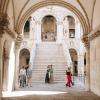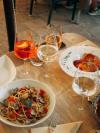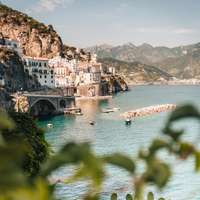A cultural guide to Venice
By Alex Gorton
January 2024
Meander along the magical city’s famed canals and marvel at some of the world’s most coveted art, Byzantine mosaics, and stately palaces
Your essential guide to the best things to see and do in Venice. Find more travel inspiration for more amazing cities here.
Is there anywhere quite as photogenic as Venice? A city of palaces that appear to float on water, it is a place of magic, mystery, Old Masters, and modern masterpieces. With more than 400 bridges spanning 150 canals, cars are banned so the only way to get around is by foot or boat—most famously, a Venetian gondola. It may be busy and expensive, but Venice is extraordinary and more than lives up to the hype.

Gondolas: The quintessential way to travel

Venetian Gothic splendor at the Doge’s Palace
Made up of six neighborhoods (sestieri) with the Grand Canal winding majestically through the middle, the area now known as Venice has been inhabited since the fifth century. Capital of the Venetian Republic between the ninth century and 1797, Venice was a major center during the Renaissance and remains a global cultural player with prestigious events, including the annual Venice Film Festival and Carnival, plus countless exhibitions and attractions open year-round such as Gallerie dell’Accademia and Ca’ Pesaro.

Rialto Bridge is the oldest crossing of the Grand Canal
Art & architecture
Start in St. Mark’s Square, arriving for early-morning mass at St. Mark’s Basilica (to beat the crowds and soak up the atmosphere), before heading to the Doge’s Palace and the Bridge of Sighs. Book the Secret Itineraries tour to see the prisons and rooms not otherwise open to the public.
From here wander through magical alleys to reach Rialto Bridge (a 16th-century masterpiece), where you can take a vaporetto waterbus down the Grand Canal to gain a close-up view of stunning 16th- and 17th-century palaces.
Whether you prefer your Titians or your Tintorettos, Venice is the home of Old Masters and the Gallerie dell’Accademia is where you can spy many of them (book in advance). For modern art, head to the Peggy Guggenheim Collection, home to works by Picasso, Matisse and Pollock, among others.
Take a break from the museums to experience a different kind of cultural treasure, the Libreria Acqua Alta, a quirky “high water” bookstore just a short walk from St. Mark’s. There you’ll find tomes piled high on shelves, stored in bathtubs and gondolas, and even stacked to form steps up to the canal outside.
Expert tips
The essentials
Fly into Marco Polo Airport (VCE). The ACTV Bus No. 5 leaves every 15 minutes between Arrivals Exits 1 & 2 and takes 25 minutes to reach the Piazzale Roma, at the entrance to the city. Buy tickets online or at the airport machines. Rideshare journeys from the airport to Piazzale Roma take around 20 minutes.
Alilaguna ferries take 40 minutes to reach the city center. Follow the signs for “Water Transport” and buy tickets at the airport dock or use cash on board. Consider a private water ferry to take you along the city’s canals directly to your destination. If arriving from within Italy, or Austria, Germany, Croatia or Slovenia, consider getting the train to Venezia Santa Lucia station.
Tipping in Italy is welcome but not expected; check your bill for a service charge. While Italian is the local language, Venetian is also spoken. English is spoken by many in tourist areas, but phrases such as ciao for hello and grazie for thank you are useful.
Getting around
Venice is built on 118 islands separated by canals and the waters of the Venice Lagoon, so traveling by gondola or water taxi is a uniquely efficient way of exploring the city. Private boat tours of Murano and Burano islands can be booked through Expedia.
There are also two tram lines and 10 bus lines. All public transportation can be paid for by Venezia Unica card or through the AVM Venezia App. Tickets can also be purchased at check-in points. The vaporetto, a public waterbus, is the cheapest way of traveling by boat, with 19 routes along the canals. Purchase tickets and maps from Piazzale Roma. Walking is an atmospheric and immersive way of exploring.
Accessibility
Venice is flat but needs planning for accessibility and mobility due to narrow streets, more than 400 bridges, few accessible restrooms, and seasonal crowds. Despite challenges exploring certain parts, around 70% of the city remains accessible, including St. Mark’s Square. Vaporetto routes 1 and 2, and both tram lines are accessible. Gallerie dell’Accademia has an open walkway and offers audio tours for people with visual impairments.
LGBTQ+
Despite some conservative attitudes, the city is typically accepting of the LGBTQ+ community. There is no dedicated Pride celebration in Venice. Visit the Dorsoduro neighborhood, specifically around Campo Santa Margherita, for LGBTQ+ bars, clubs and restaurants.

Spaghetti alle vongole and an Aperol spritz? Yes, please
Food & drink
One of the many great joys of Venice is to enjoy a selection of cicchetti (small plates of delicious food) and an ombra (small glass of wine) from a bacari, a low-key bar. Order market-fresh bites at All’Arco, a gorgeous hole-in-the wall bar near Rialto Bridge, head to Salvmeria on Via Garibaldi, or stop off at Cantina Do Mori, the oldest bacaro in the city.
A spritz is another Venetian must-try (choose Select over Aperol for a truly local experience). Head to Caffè Florian in St. Mark’s Square or AcquaStanca on nearby Murano island. The other great Venetian drink is the Bellini, which was invented at the legendary Harry’s Bar.

Flights, camera, action: Set-jetting in Italy
From Roman Holiday to Ripley, these are the best filming locations to visit in Italy
Watch before you go
A city as pretty as Venice is made for the big screen. St. Mark’s Square has been featured in numerous films including The Talented Mr. Ripley, Casino Royale, The Tourist, and Spider-Man: Far From Home. But perhaps its most iconic role was in Don’t Look Now, the 1973 thriller adapted from a short story by Daphne du Maurier.

The Piazza San Marco has starred in films including The Tourist
Hot ticket
The prestigious cultural extravaganza Venice Biennale takes place in alternate years and showcases art (in even years) and architecture (in odd years). Open for six months from May to November, this world-renowned exhibition has launched the careers of many celebrated artists and architects. Advance tickets are available on the Biennale’s website for programming that takes place in the 12th-century Arsenale, a former shipyard complex, and Giardini, a city park, though many exhibitions in palazzos across the city offer free entry.
First time? Base yourself at Rosa Salva Hotel in San Marco, the most central Venetian neighborhood. Home to many of the major sights (think St. Mark’s Square, the Bridge of Sighs, Doge’s Palace), by staying here you can easily start early/stay late to avoid some of the (many) crowds. Packed with hotels, galleries, restaurants, and chic boutiques, it’s a buzzy and busy area with everything within easy walking distance.
With a younger crowd than much of Venice (thanks to the university), Dorsoduro has plenty of good neighborhood restaurants, lively bars, and small independent boutiques. It’s also home to arty big hitters such as the Accademia, Punta della Dogana and Guggenheim, as well as a pretty gondola boatyard and the Zattere promenade, which offers gorgeous views of the island of Giudecca.

Alex Gorton is a freelance writer, as well as the former travel editor of Condé Nast Brides. She has visited countries all over the globe, from Chile to Namibia, and lived in France, Canada, and the U.S.
Hotel deals in Venice






